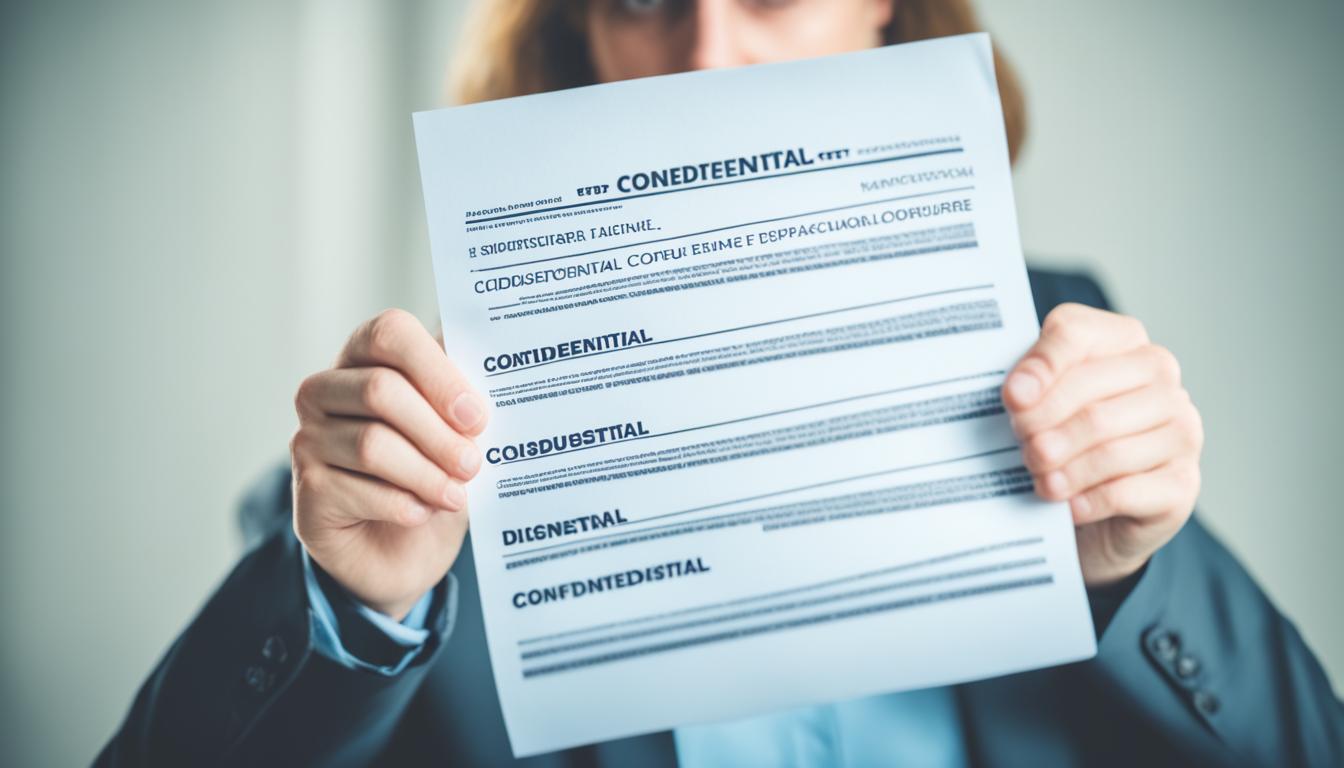Have you ever wondered what goes on behind closed doors during business negotiations? How do companies protect their secret sauce from falling into the wrong hands? The answer lies in a powerful legal tool called the Non-Disclosure Agreement, or NDA. But exactly what is a non disclosure agreement, and why is it so important in today’s competitive business world?
A non disclosure agreement, also known as an NDA or confidentiality agreement, is a legally binding contract that establishes a confidential relationship between two parties. It plays a crucial role in safeguarding sensitive information from being disclosed to others, ensuring that crucial trade secrets, customer data, and proprietary information are kept under lock and key.
So, what does an NDA entail, and why should you consider using one? Join us as we explore the ins and outs of non-disclosure agreements, uncover their different types, and discover when and how they should be used. Buckle up and get ready for an eye-opening journey into the world of NDA’s.
Types of Non-Disclosure Agreements
Non-disclosure agreements, commonly known as NDAs, come in different forms to cater to various situations. Understanding the different types of NDAs can help you choose the one that best suits your needs.
Mutual Non-Disclosure Agreement
The mutual non-disclosure agreement is used when two parties are engaged in discussions for potential partnerships or joint ventures. In this agreement, both parties promise to keep any shared information confidential. It ensures that both sides are equally bound by the terms of confidentiality.
Non-Mutual Non-Disclosure Agreement
A non-mutual non-disclosure agreement, on the other hand, is employed when only one party is responsible for keeping the information they receive confidential. This type of NDA is often used when an employee or contractor requires access to sensitive company information. The agreement ensures that the individual understands their obligation to maintain confidentiality.
Disclosure Agreement
A disclosure agreement is another type of NDA which allows one party to share specific information with others while still maintaining confidentiality. For example, a doctor may share medical details with an insurance company to process a claim. The disclosure agreement outlines the authorized recipients and the circumstances under which the information can be shared.
Choosing the right type of non-disclosure agreement depends on the specific situation and the parties involved. It’s essential to carefully consider the needs and requirements of your business or personal circumstances to ensure effective protection of confidential information.

Requirements for a Non-Disclosure Agreement
A non-disclosure agreement (NDA) is a legally binding contract that must meet specific requirements to be enforceable. When drafting an NDA, there are several key elements to consider:
Participants to the Agreement
In an NDA, it is essential to clearly identify the parties involved and specify their roles. This includes defining who is bound by the agreement (the disclosing party) and who is receiving the confidential information (the receiving party).
Definition of Confidential Information
The NDA should include a comprehensive definition of what information is considered confidential. This definition should be clear and specific, ensuring that all parties understand the scope of protected information.
Exclusions of Confidentiality
While an NDA aims to protect confidential information, certain types of information may be excluded. These exclusions should be clearly outlined in the agreement to avoid any potential misunderstandings or disputes.
Appropriate Uses of Information
The NDA should also specify the permitted uses of the confidential information. This may include restrictions on copying, sharing, or disclosing the information to third parties. It is important to outline these permitted uses to avoid any misuse or unauthorized disclosure of the information.
Time Period
Another crucial aspect of an NDA is the duration of confidentiality. The agreement should specify the length of time during which the information must remain confidential. After this specified period, the receiving party may be permitted to use or disclose the information.
Other/Miscellaneous Provisions
In addition to the above requirements, an NDA may include other provisions, such as the choice of law and jurisdiction. These provisions ensure that the agreement is governed by specific legal principles and that any disputes arising from the NDA will be resolved in a particular jurisdiction.
An NDA that meets these requirements establishes a legally binding agreement that safeguards confidential information and protects the interests of all parties involved in the agreement.
Information Protected With a Non-Disclosure Agreement
A non-disclosure agreement (NDA) ensures the protection of valuable information. The NDA safeguards sensitive data, thereby maintaining confidentiality and a competitive edge in various business scenarios. Some examples of the information covered by an NDA include:
- Customer Information: NDAs safeguard details related to major customers, including their contact information.
- Financial Information: Specific financial data that is not required to be publicly disclosed is protected by an NDA.
- Intellectual Property: NDAs provide security for intellectual property assets, such as patents, copyrights, and trade secrets.
- Marketing Information: Information pertaining to marketing strategies and campaigns is kept confidential with the help of an NDA.
- Operating Information: NDAs protect sensitive operating details, ensuring that valuable internal knowledge remains undisclosed.
An NDA could cover other forms of vital business information that could potentially give a competitive advantage. The specificity and extent of protection depend on the nature of the agreement and the type of information being shared.
“Keeping customer data and financial information confidential is essential for maintaining trust, while safeguarding intellectual property and marketing strategies helps businesses secure their competitive advantage.” – LegalExpert

When to Use a Non-Disclosure Agreement?
Non-disclosure agreements (NDAs) are essential tools that are used in various situations to safeguard sensitive information and protect confidential relationships. Understanding the situations requiring a non-disclosure agreement is crucial for businesses and individuals alike.
Situations Requiring a Non-Disclosure Agreement
There are several situations where a non-disclosure agreement is necessary:
- Business Negotiations: When engaging in discussions about potential partnerships, joint ventures, or securing funding, NDAs ensure that sensitive information disclosed during these negotiations remains confidential.
- Hiring Employees: When hiring new employees, especially those who will have access to confidential business information, NDAs offer protection against the unauthorized disclosure of sensitive data.
- Industry Standards: Certain industries, such as tech companies, require employees to sign NDAs as a standard practice to safeguard proprietary information and maintain a competitive edge.
- Personal Relationships: In personal relationships, such as entering into a prenuptial agreement or sharing personal information with a trusted individual, NDAs can help ensure privacy and maintain trust.
Purpose of an NDA
The purpose of an NDA is to establish clear guidelines and legal obligations regarding confidential information. By defining the boundaries of what information can and cannot be shared, an NDA provides peace of mind and encourages open communication while protecting valuable assets.
Signing an NDA as an Individual
Individuals may also be required to sign NDAs in specific circumstances, such as when working on confidential projects or collaborating with businesses that value the protection of their intellectual property. By signing an NDA as an individual, you are committing to keeping specified information confidential, ensuring the continued trust and cooperation of the parties involved.
Using non-disclosure agreements appropriately can provide peace of mind and protect valuable information. Whether used in business or personal settings, NDAs play a crucial role in maintaining trust and confidentiality.

When Not to Use a Non-Disclosure Agreement?
A non-disclosure agreement (NDA) is a valuable tool for protecting sensitive information, but there are instances where it should not be used. It is crucial to consider the moral and ethical implications of utilizing an NDA and whether it may have negative consequences. Let’s explore situations where an NDA should not be employed:
1. Confidentiality Already Exists
If confidentiality is already ensured by data protection laws or other legal obligations, implementing an NDA may be unnecessary. It is essential to review the existing safeguards to determine if an additional agreement is warranted.
2. Reporting Discrimination or Harassment
Using an NDA to prevent someone from reporting discrimination or harassment in the workplace is highly inappropriate. Individuals should feel empowered to speak up about such misconduct without fear of retribution or silencing.
3. Covering Up Inappropriate Behavior
NDAs should not be employed to conceal inappropriate behavior or misconduct that requires addressing. Transparency and accountability are essential in promoting a safe and respectful work environment.
4. Avoiding Dispute Resolution
While NDAs can help resolve conflicts, they should not be used to bypass proper dispute resolution processes. It is important to address disagreements openly and fairly, ensuring all parties have an opportunity to voice their concerns.
“Using an NDA should not be an instrument to mislead or deceive someone.”
When considering the use of an NDA, it is crucial to evaluate the potential consequences and ethical implications. Some situations may call for alternatives to protect sensitive information or resolve disputes without compromising transparency and fairness.
| Situations | When Not to Use an NDA |
|---|---|
| Confidentiality Already Exists | When information is already protected by data protection laws or other legal obligations |
| Reporting Discrimination or Harassment | When attempting to silence individuals from reporting workplace misconduct |
| Covering Up Inappropriate Behavior | When the purpose is to conceal inappropriate behavior or misconduct |
| Avoiding Dispute Resolution | When evading proper procedures for resolving disputes |
Resolving Problems at Work without Non-Disclosure Agreements
Instead of relying solely on non-disclosure agreements, employers should focus on resolving problems at work through proper policies and procedures. By following correct policies and procedures, employers can ensure a fair and transparent work environment that promotes open communication and timely dispute resolution.
One important aspect of resolving problems at work is to establish and implement disciplinary or grievance procedures. These procedures provide a framework for addressing employee conflicts and concerns in a structured manner, ensuring that all parties are treated fairly and impartially. Conducting thorough investigations into any allegations or complaints is vital to gather all the necessary information and make well-informed decisions.
Another crucial component is having whistleblowing procedures in place. Whistleblowing mechanisms encourage employees to report any wrongdoing or unethical behavior they witness at work. This helps in identifying and addressing issues before they escalate, fostering a culture of accountability and integrity.
Creating a good culture at work is equally essential for resolving problems effectively. Employers should strive to cultivate an environment where employees feel comfortable speaking up and having their concerns addressed. This involves actively promoting open and respectful communication, encouraging collaboration and teamwork.
Training managers to identify and resolve disagreements early on is also key. Equipping managers with conflict resolution skills enables them to intervene proactively, mediate conflicts, and find mutually beneficial solutions. Effective conflict resolution can prevent small issues from escalating into major problems, preserving a positive work environment.
“Investing in employee training and development in conflict resolution and communication skills can go a long way in preventing and resolving workplace problems.” – HR Expert
Resolving problems at work in a fair and open manner not only avoids legal action but also fosters a positive work environment and employee satisfaction. By prioritizing the implementation of correct policies, creating a favorable work culture, and training managers, employers can effectively address and resolve workplace problems.
| Benefits of Resolving Problems at Work | Techniques for Problem Resolution |
|---|---|
| 1. Avoiding costly legal disputes | 1. Disciplinary or grievance procedures |
| 2. Preserving a positive work environment | 2. Thorough investigations |
| 3. Enhancing employee satisfaction and morale | 3. Implementing whistleblowing procedures |
| 4. Minimizing disruptions in productivity | 4. Creating a good culture at work |
| 5. Strengthening relationships within the organization | 5. Training managers in conflict resolution |
Conclusion
Non-disclosure agreements (NDAs) are essential for safeguarding sensitive information and maintaining a competitive edge. These legally binding contracts establish a confidential relationship between parties and are used in various scenarios, including business negotiations, employee contracts, and personal relationships. It is crucial to ensure that NDAs meet legal requirements and address specific needs.
However, it is important to note that NDAs should not be used to prevent individuals from reporting harassment or discrimination or to cover up inappropriate behavior. Employers should prioritize resolving workplace issues through proper policies, procedures, and a positive work culture. By doing so, they can avoid legal complications, retain talented employees, and foster a respectful and productive work environment.
Employers should understand that enforcing NDAs can be challenging. While NDAs protect sensitive information, they do not silence employees when it comes to reporting workplace problems. In fact, creating an atmosphere of open communication and providing mechanisms for dispute resolution is far more effective in addressing conflicts and fostering a thriving work environment.
In conclusion, non-disclosure agreements have their benefits in terms of protecting confidential information, but they should be used responsibly and in conjunction with effective workplace policies. Prioritizing problem resolution, promoting a positive work culture, and upholding fair and transparent practices are the keys to creating a harmonious and successful workplace.




